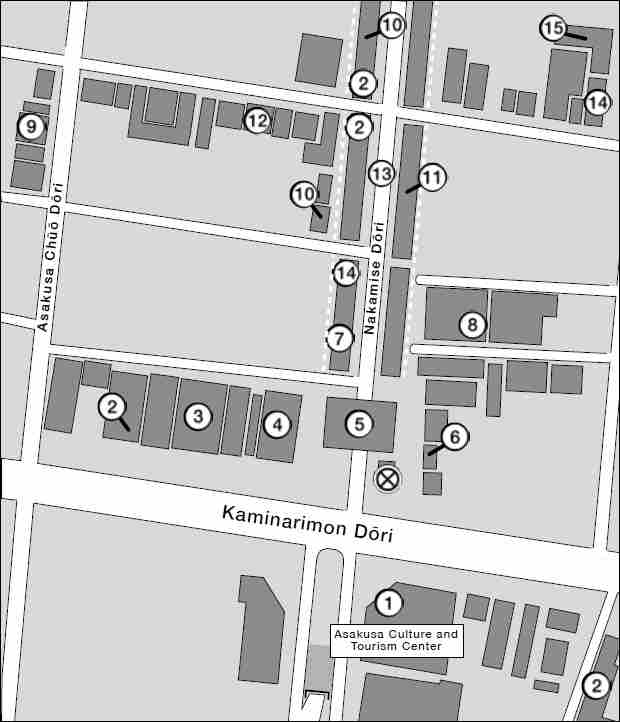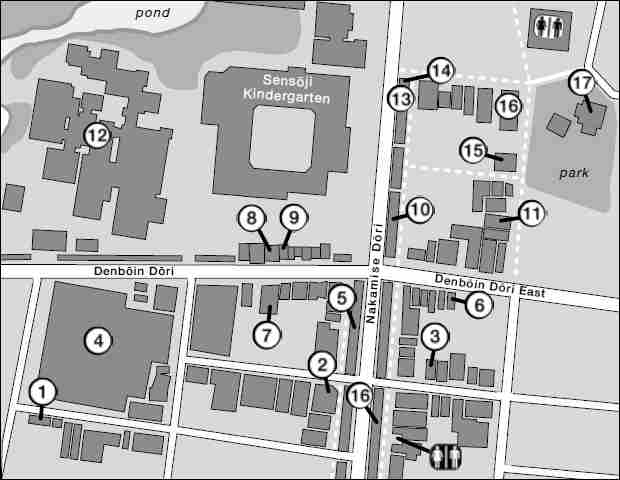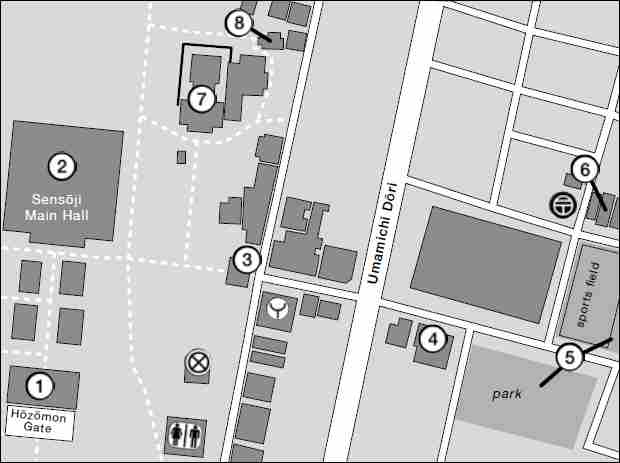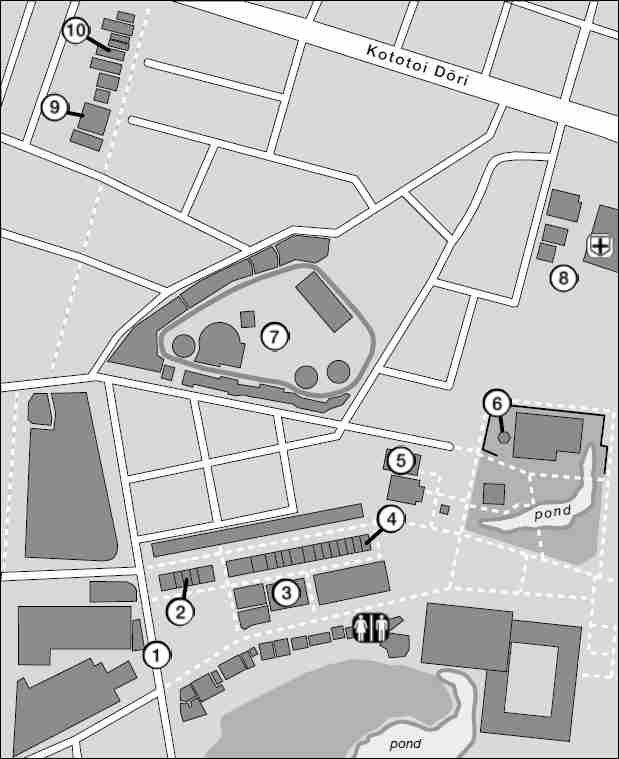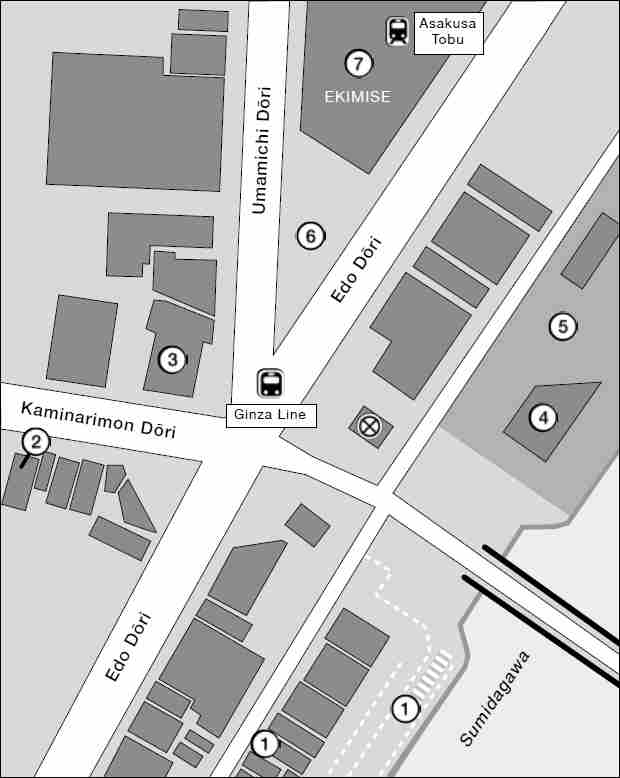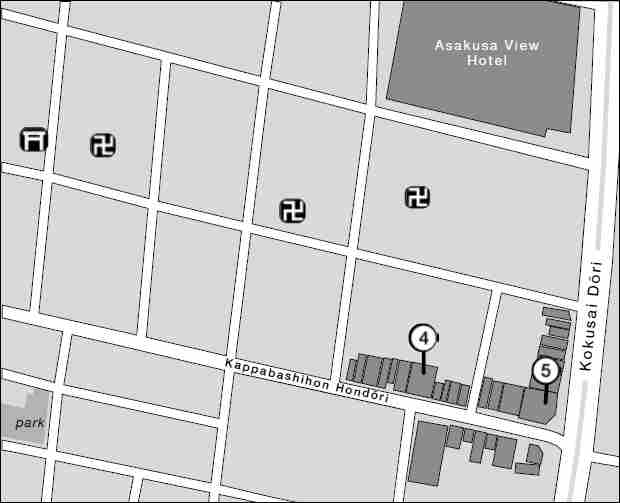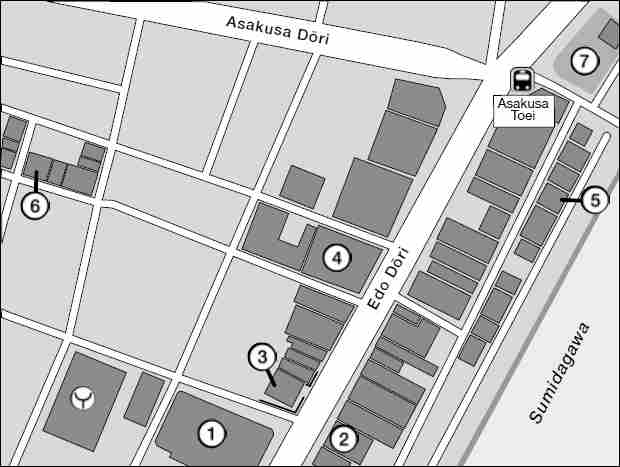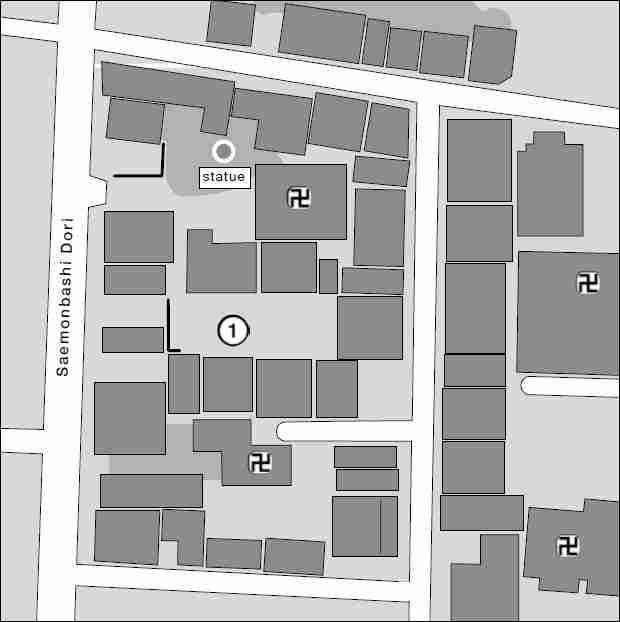浅草
ASAKUSA
My home base when I visit Tokyo, Asakusa is located on the west bank of Tokyo’s major river, the Sumidagawa. Several major subway and rail lines provide easy transit to and from this area. Older buildings are common and the atmosphere is laid back, with plenty of small family-run businesses and restaurants. Many of the shops in the Asakusa area date from the 19th century, and some from the days when the Tokugawa shōguns still ruled Japan. Asakusa has been a pilgrimage site since the early 7th century when the famous temple Sensōji was established. In the early Edo period the temple became surrounded with a large variety of shops, and in 1657 the Yoshiwara prostitution red light district was relocated a short distance north of the temple, bringing in a different kind of pilgrim. In 1842 the kabuki and bunraku theaters were moved to the area during a government crackdown on frivolity, likely in the hope the theaters would lose business and fail. The result was the establishment of a lively entertainment district that would produce some of Japan’s first Western-style dance halls and jazz clubs; the first movie theater, Denkikan; and in the post-war period, the first strip joints. Today the kabuki and bunraku theaters have relocated to the Ginza and Nihonbashi and the dance halls are gone, but remaining are small-stage theaters, a yose where you can enjoy rakugo, the oldest Western-style bar in Japan, local artisan-run shops that have been in operation for generations, and one strip joint, the Rock-Za. If you go a little north behind the temple, you will find what appears to be just a residential area. Look closer and you will spot ryōtei, those classic restaurants where geisha provide music and dance for private parties. Each summer in August the Asakusa Samba Carnival takes place. This is one of the major summer festivals of Tokyo, with dancers going down the main street for hours.
All of this means that this chapter is the longest in the book, not because of any favoritism on my part, but due to the density of what is there.
KANJI NOTE: The kanji for Asakusa can be read two ways. The other reading is Sensō, as in Sensōji.
ETIQUETTE NOTE: This area is very crowded, so it is very important to not eat or drink while strolling around.
NAVIGATION NOTES: Unlike most of Tokyo, the smaller streets near the temple often, but not always, have names. However, they rarely have signs identifying them.
There are four separate stations named Asakusa Station, so know which one you want. The subway stations for the Ginza Line and the Asakusa Line are blocks apart near the Sumidagawa. The rail stations include one for the Tōbu Railways just north of the Ginza Line station, and one for the Tsukuba Express located underground on Kokusai Dōri several blocks further west.
DETAIL 1
 Asakusa Culture Tourist Information Center 浅草文化観光センター
Asakusa Culture Tourist Information Center 浅草文化観光センター
This is a good place to start your visit to Asakusa. Staff can speak Japanese, English, Chinese, and Korean. There is free wi-fi, a nursing room, currency exchange, event rooms, and ticket sales for many events. There is also a restaurant and observation deck on the top floor with good views of both the Sensōji area and across the Sumidagawa. The building was designed by Kengo Kuma and Associates to resemble neatly stacked wooden structures.
A confectioner in business since 1902 with multiple locations: a main shop at the intersection of Shin Nakamise and Orange Street, branches on Kaminarimon Dori, two at the intersection of the Nakamise and Shin Nakamise, and a cafe south of Kaminarimon Dōri (east of the Asakusa Culture and Tourism Center). Their specialty is confections made from sweet potato (imo) paste. At the time they developed their first recipes, traditional sweets were too expensive for many, but imo proved to be an inexpensive ingredient. Today they have a variety of sweets to eat there or to take with you from all the locations.
ASAKUSA WEST
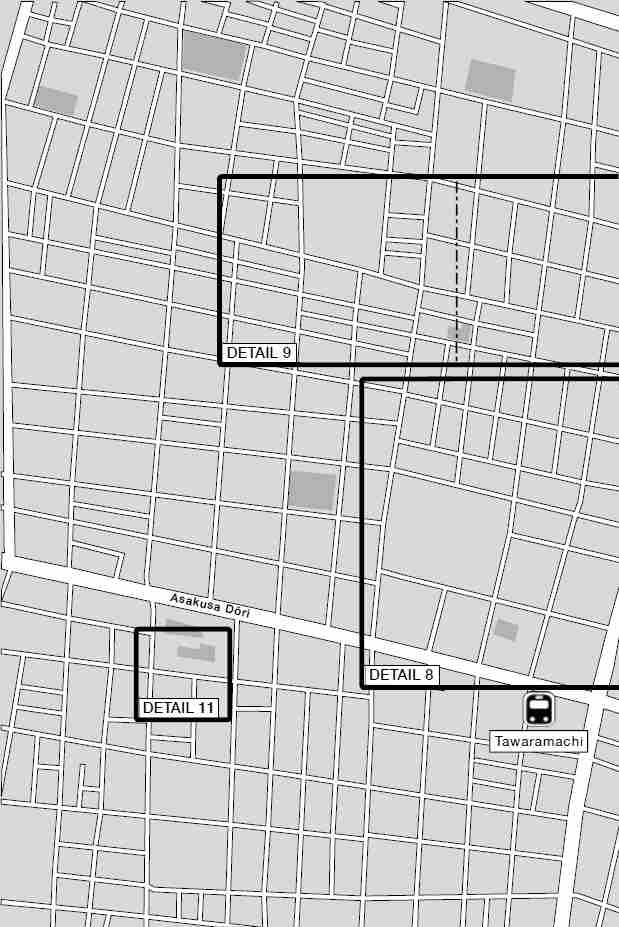
ASAKUSA EAST

ASAKUSA DETAIL 1
Chin-ya was established in the Edo period as a business providing pets and veterinary services to high-ranking samurai and wealthy merchant households. In 1880 the owners changed the business into a restaurant but kept the old nickname, which means “Pekingese Shop” or “Chinese shop.” As you enter, remove your shoes and exchange them for a wooden tally with a black number on it. Chin-ya specializes in high-quality sukiyaki and shabu shabu. You can enjoy your meal in either traditional Japanese- or Western-style seating. When you pay, the staff will exchange your shoe tally for one with a red number, which you can then use to claim your shoes. The original building suffered damage in both the Great Kantō Earthquake and World War II; the brick building dates from 1975.
 Tokiwadō Kaminari Okoshi Honpo 常盤堂雷おこし本舗
Tokiwadō Kaminari Okoshi Honpo 常盤堂雷おこし本舗
Located to the left of the Kaminarimon of Sensōji, this is the main store, though the company has a few other branches in the Tokyo area. For over 250 years this business has been making confections. They are especially known for their kaminari okoshi, bars made of puffed grain, sugar and, other ingredients for flavor such as peanuts or green tea. You can watch them being made through a window into the shop. The store also makes and sells ningyōyaki with a variety of fillings and shapes, including characters from the popular TV show “Shōten,” as well as karintō crackers in various flavors. Products are sold in bags, individually wrapped, and in wood boxes for special items. Okoshi make an excellent tasty lightweight gift to bring home.
On Kaminarimon Dōri at the entrance to the Nakamise is a massive gate that has come to symbolize the Asakusa neighborhood. Originally built in 941, the gate burned three times: the first in 1642, again in 1767, and it was at last destroyed by fire in 1865. The current gate was constructed in 1960 with donations from Matsushita Kōnosuke, who founded Matsushita Electric, now known as Panasonic. Between 1865 and 1960 people would still speak of the former location of the gate as Kaminarimon. This large gate is easy to spot as it sports a huge lantern over ten feet (3.3 meters) tall. Every ten years a new lantern is put up. Statues of the wind god Fūjin and the thunder god Raijin—who is also known as Kaminari—are in either side of the gate as you face Sensōji. The gate’s official name, Fūraijin Mon, is written on the back of the lantern. On the back side of the gate there are statues of two Buddhist deities: Tenryū on the left, and Kinryū on the right. These two statues were donated in 1978.
Located immediately east of the Kaminarimon—just look for the wooden signboards above the awning at the entrance—this shop has been in business since 1856 selling a large number of paper products. Viewing their selection of sheets of printed paper at first glance gives the impression that you are looking at a display in a fabric shop. You will also find papier-mâché items, stationery goods, traditional and modern Japanese prints, hanging scrolls, beautiful goshuinchō (notebooks for collecting shrine stamps), and more.
A shop selling a variety of snack foods since 1876. These consist of charcoal-roasted rice crackers, ningyōyaki (which you can watch being made), kaminari okoshi, and other treats such as various snacks made of beans and nuts; roasted, fried, or glazed. Most are packaged for convenience, however some you can buy by weight. Such treats are a bit of tradition and are good with tea, beer, or sake. Many are dry and store well so you can bring them home as gifts. Bairindō is very easy to find, being the third Nakamise shop on the left after the Kaminarimon.
 Sake no Daimasu Kaminarimon Branch 酒の大桝 雷門店
Sake no Daimasu Kaminarimon Branch 酒の大桝 雷門店
This combination izakaya and liquor store is a branch of the local Daimasu liquor store, which was founded in 1930. This branch has a focus on sake, with a selection of local beers, and has a small menu of side dishes to enjoy with your drinks. If they don’t have the sake you want and their main store does, you can have a bottle brought over for a corking fee, or pick it up yourself. They have an English menu, credit cards are accepted, and Western cutlery is available.
 http://www.e-daimasu.com/sakebar/index.html
http://www.e-daimasu.com/sakebar/index.html
This shop specializes in hand dyed tenugui and other dyed cloth goods. The patterns sold vary with the seasons. Their tenugui are 100 cm long, whereas the usual length is about 90 cm. They also sell Aloha shirts, fans bundled with matching tenugui, kakejikubō mounts for displaying tenugui, and more. They have been in business since 1907 and their products are also sold in various shops across Japan. They will do custom tenugui and aloha shirts based on their designs, but orders take some time to fill so are not an option for most tourists.
 Arai Bunsendō aka Bunsendō 荒井文扇堂
Arai Bunsendō aka Bunsendō 荒井文扇堂
A handheld fan shop with a history going back to the Meiji period. There are two locations near each other: the original on the west side of the Nakamise in the third block from Kaminarimon, and the branch store, just west of the Nakamise at the first intersection. Their fans range from very high-quality handmade folding fans—which are popular with geisha, professional performers of traditional dance, kabuki actors, and rakugo storytellers—to inexpensive and whimsical non-folding uchiwa fans.
In operation for over 100 years, Kikuya is located in the second block of the Nakamise, the ninth shop from Kaminarimon. They produce several types of daifuku and dango plus a few other sweets, and sell containers of powdered green tea. This is a good place to get a small sweet and snack on it to give you an energy bump before continuing down the Nakamise. You can also get items to go—use the phrase “to go” and they will understand. If they sell out of stock, they close for the rest of the day.
 https://www.kikuya-nakamise.com
https://www.kikuya-nakamise.com
A store specializing in belts for kimono, known as obi in Japanese, since 1920. The many styles for men and women range from narrow to wide, and simple to ornate. The obi on display are changed seasonally depending on their color or printed motifs. Most of the obi are from looms in the Hakata area of Fukuoka and from Nishijin in Kyoto, two places famous for their woven fabrics. It is recommended that you bring in your kimono when selecting an obi to go with it.
This is a pedestrian shopping street just shy of 980 feet (300 meters) long, divided into seven blocks. The eighty-eight shops located here are all between the Kaminarimon and the Hōzōmon. While you will find some mass-produced cheap toys and souvenirs, several of the shops have high-quality handmade items for reasonable prices. Be aware that the street can be very crowded, so you need to take your time to look at the goods. Who knows, you may discover very unique items for yourself or for gifts. You can also find a variety of locally-made snack foods sold either freshly made or packaged. Two of my favorite shops on the Nakamise include Bunsendō for fans, and Sukeroku for small handcrafted Edo-style toys.
 http://asakusa-nakamise.jp/e-index.html
http://asakusa-nakamise.jp/e-index.html
Nakamise Murals
If you wake up early in the morning and go to the Nakamise well before everything opens, you will see the lowered shop shutters painted with murals relating to the Asakusa neighborhood. The murals were added in 1992 at the suggestion of Professor Hirayama Ikuo, president of the Tokyo University of the Arts.
This restaurant was founded in 1940 and has been operating in the present location since 1952. The menu includes a variety of Japanese as well as Japanese-style Western and Chinese dishes. Set meals are also on the menu. Seasonal items and Japanese deserts are also served, banquet courses are available by reservation only.
The first floor has Western seating, the second floor is all Japanese seating with horigotatsu. The restaurant has some English speaking staff and an English menu is available.
There is a branch shop on the Nakamise, Kibidango Azuma, at the end of the first block on the left after the Kaminarimon gate. This branch sells kibidango, a traditional Japanese sweet. Both shops are open 7 days a week.
The restaurant is non-smoking, restrooms are on both floors.
 Yagenbori Nakajima Shōten やげん堀 中島商店
Yagenbori Nakajima Shōten やげん堀 中島商店
A shop specializing in shichimi tōgarashi, a blend of seven spices that can be sprinkled over any of several dishes. While this spice mix exists in various forms all over Japan and is now sold in many other parts of the world, it originated at this shop employing Chinese medicinal knowledge to make something both tasty and good for your health. The original shop location was in an area with many doctors and medicine wholesalers; in 1943 the business relocated to Asakusa. They have three different ready-made mixes with varying levels of chili powder, or you can request different levels of heat and watch as they mix your order. They also sell attractive re-useable wooden storage containers in the shapes of a barrel, a gourd, or a length of bamboo, as well as furikake and some individual spices. The shop name Yagenbori comes from a canal shaped like a type of mortar called a yagen that is used to grind medicinal herbs.
There are two stores in Asakusa, the main store on Shin-Nakamise Dōri, and a branch on Metro Street.
NOTE: In Kurosawa Akira’s film Red Beard, there is a scene early on where you see a yagen being used to grind medicine.
DETAIL 2
A shop specializing in items made of gold and silver, all handmade in-house since 1927. Items for sale include netsuke, tableware, drinking cups, chopsticks, Buddhist altar fittings, wind chimes, ornaments, earpicks, accessories, and more.
 https://www.asakusamorigin.com/english/
https://www.asakusamorigin.com/english/
ASAKUSA DETAIL 2
This tea house/cafe, whose name translates as Plum Garden, specializes in Japanese sweets. It first opened in 1854. They have several types of oshiruko, a sweet dessert soup served in a bowl. Anmitsu, made with fruit and other sweets, is also popular. One famous dish is awazenzai, millet cakes covered in sweet azuki bean paste. They also serve ice cream and some dishes come with whipped cream. They have a few take-out items on the menu. Don’t be surprised if all the seats are taken, as in Nagai Kafū’s novel The Dancer where a character is unable to sit because the place is full of customers.
 http://www.asakusa-umezono.co.jp
http://www.asakusa-umezono.co.jp
Isekan was established in 1717 when Tokyo Bay was the major location for nori production in Japan and Asakusa was a major center for its distribution. Several types of nori in sheet form, tsukudani paste made from nori, and a few other items are sold. They have two stores: The main one is on a corner just south of the Nakamise on the cross street between the fourth and fifth blocks, and the branch is on the second block of the Nakamise on the left side.
 Asakusa Public Hall / Asakusa Kōkaidō 浅草公会堂
Asakusa Public Hall / Asakusa Kōkaidō 浅草公会堂
A general-purpose event space that opened in 1977, the hall is best known for the Shinshun Asakusa Kabuki (Asakusa New Year’s Kabuki) stage performances held in January. Other performances in the theater may include traditional or modern dance, song festivals, jazz, lectures, workshops, and various popular entertainments. The facilities include the large theater, an exhibit hall, and a tea house that serves reasonably priced meals. The Stars’ Plaza (Star no Hiroba) in front of the hall consists of metal castings of handprints and autographs of famous entertainers connected with Asakusa.
 https://asakusa-koukaidou.net/en
https://asakusa-koukaidou.net/en
This shop established in 1941 deals in a variety of items including handmade reproductions of traditional woodblock prints; small paintings; Buddhist statuary in wood, metal, or plastic; papier-mâché masks (including lots of yōkai and folk masks); samurai figures, kokeshi dolls; and a changing selection of other small items.
Established in 1912, this store is devoted to traditional Japanese footwear for men, women, and children. They make and stock geta, zōri, setta, and all sorts of other traditional footwear. A wide range of materials are used to make them including wood, leather, fabric, bamboo, snakeskin, and hemp cloth. The stock ranges from items for formal kimono wear to many that are suitable for casual wear, for example geta with skull patterns on the straps.
Yonoya Kushiho was established in the Hongō area of present-day Bunkyō Ward in 1717 and moved to this location in the late Meiji period. Presently located on Denbōin Dōri, this is one of two shops in Tokyo devoted to traditional wooden combs (the other being Jūsanya in Hongō). They also have a selection of traditional handmade hair ornaments. The wood used to handcraft their products comes from Ibusuki in Kagoshima Prefecture and is carefully selected and specially aged for a full year. Such items can last for generations if properly taken care of.
This small shop is easy to find: above the shop you will see a decoration in the form of a ladder with a traditional bell attached to the top, and the shop’s sign has the name in white on a red circle. Asakusa Menchi serves only one thing, a classic Japanese street food called menchi katsu that consists of breaded, spiced minced pork and beef, mixed with vegetables and deep fried. Be careful with that first bite as the outside is crispy but the inside is very hot and juicy. I first had menchi katsu here on a snowy morning, when it was a perfect snack to warm me up. There is a bottle of karashi (Japanese mustard) on the counter if you want to spice it up. I advise trying it plain first as it is very tasty by itself.
You can’t get more specialized than literally selling just one thing. Toyofuku has been doing this for over 100 years. They sell karēpan (curry bread) made with high-quality kuroge wagyu beef. The only choices on the menu are regular or spicy. Japanese spicy is pretty mild, so don’t worry if you don’t speak the language. This place is so busy that as soon as they make some karēpan buns, they hand them to waiting customers. Even if there is a line, and there often is, it will move fast. Do note this is a crowded area so don’t walk around eating your curry bun.
 Asakusa Chōchin Monaka 浅草ちょうちんもなか
Asakusa Chōchin Monaka 浅草ちょうちんもなか
This shop sells monaka with ice cream filling between two crispy wafers instead of the usual sweet ankō. The wafers are in the shape of the Kaminarimon lantern. They also sell seasonal ice cream flavors and items such as shaved ice in the summer with seasonal fruit flavors, fruit vinegar juice from March to November, and oshiruko and amazake in the winter. They also sell traditional monaka including boxed sets.
 https://www.cyouchinmonaka.com
https://www.cyouchinmonaka.com
A shop located near Sensōji, on the block just southwest of the Bentendō, open since 1946. Look for a blue noren with a repeating fuji flower (wisteria) pattern in white that is put out when they are open. They specialize in traditionally dyed Japanese cotton tenugui, usually translated as hand towel. In Japan these are more than just towels—they are also traditionally used as head coverings, rolled into headbands, for wrapping items to carry, and so on. The different colorful designs are both traditional and modern. Bunraku, kabuki, ukiyo-e, and seasonal motifs all are among the inspirations. I have a lovely one of a woman in the snow that I bought on a cold January day, and the next day it did snow. They have some 200 unique designs made by the store. They are so attractive that some people mount them as art, which costs more than the tenugui but can be worth it. There is not enough room for all the designs, so they periodically change them, often according to the season.
The official residence and office of the head priest of Sensōji. The name is sometimes romanized as Denbōin. The main buildings date from 1777. Denpōin is known for its Edo period garden designed in the 17th century by the tea master Kobori Enshū. The garden features a large double pond shaped like the kanji for kokoro, “heart” or “feelings.” The garden is private, however beginning in 2012, to raise money for the victims of the 2011 earthquake, access has been allowed starting in mid-March through early April or May. Pay for entry at the temple office in the five-story pagoda. At other times the garden is partly viewable through the fence at Chingodō.
Photographers inside the garden can get a good view of the pagoda and Tokyo Sky Tree with the garden in the foreground.
This very small shop, big enough for only two or three customers at a time, sells handmade traditional toys in the style of the Edo period. In fact they have been in business since 1866 when the Edo period was winding down. Many of these are very cleverly made, such as a tiger made from a sheet of painted paper and small weights that always lands on its feet. The materials vary greatly: ceramic, papier-mâché, wood, bamboo, cloth, plaster, and more are all used depending on the toy. Literally thousands of toys of a wide variety are available: figures of people of various occupations, animals, good luck charms, kabuki actors, street scenes, even wordplays based on the subjects and materials, and much more. There have been so many designs made and sold by this shop over the years that you can buy bilingual hardcover catalogs with color illustrations at the shop.
TIP: Go on a weekday when the store is less crowded, especially if it is rainy.
A shop in the seventh block of the Nakamise selling ningyōyaki with several Sensōji-themed designs originated by the store. These include the five-story pagoda, Raijin (whose statue is in the Kaminarimon), one of the gate lanterns, and a pigeon. The pigeon is modeled after a ceramic charm of a pair of pigeons that used to be sold by a nearby shop. One of their sweets is good for a pick-me-up after having strolled the length of the Nakamise. They have been in operation since 1868.
Popular with kabuki actors, geisha, and traditional Japanese dance performers, Hyakusuke has been selling traditional makeup for over 200 years. It is easy to find as the location is across from the children’s playground near the Bentendō. They also sell a variety of handcrafted Japanese makeup brushes and wooden combs. This is apparently the last place in Tokyo to sell a traditional powdered skin cleanser made with nightingale droppings. It is sold in an attractive pink package with a plum blossom decoration.
Since 1910 this festival goods specialty store has been making and selling all the clothing supplies one needs to have a traditional matsuri look, as well as various accessories including necklaces, lanterns, kimono bags, and tenugui to roll into a headband. They also sell other garments such as wataire hanten. You can even order tegaki fuda, which are card-sized wood blocks with your name handwritten on them. There are two shops, one located on the east side of block four of the Nakamise and the other directly across from the Bentendō.
 Bentendō 弁天堂 and Bentenyama 弁天山
Bentendō 弁天堂 and Bentenyama 弁天山
A little way southeast of the Hōzōmon of Sensōji, at the edge of the temple grounds, is an ancient burial mound known as Bentenyama. The name of this mound comes from a small red temple to the Goddess Benten located on top of the mound. The statue here is of Rōjo Benzaiten with distinguishing white hair, and it is considered one of the three most famous Benten statues of the Kantō. The statue can only be viewed on special festival days. The present building was rebuilt in 1983. This is also the location of the famous bell of Sensōji. This bell was one of two bells that were used to ring the hours for the city in the Edo period, the other being at Kan’eiji in Ueno. While the bell tower was destroyed in World War II, the bell was unharmed. If you find yourself at Sensōji minutes before the New Year begins, you can see the bell being rung 108 times starting at midnight. It is also struck at 6:00 each evening. The bell itself is a recasting from 1692 and is famously referred to in haiku by Bashō. Illustrations in early 19th-century works such as Matsudaira Kanzan’s Sensōji Shi and Saitō Gesshin’s Edo Meisho Zue show that there was once open water at the base of the hill. Water is associated with the godess Benten and usually found near her shrines.
DETAIL 3
An impressive two-story gate just before Sensōji, beyond the far end of the Nakamise. The name of the gate, which is used to house many treasures of the temple, translates as “Treasure Storage Gate.” Many also refer to it as the Niōmon since there are two Niō statues on either side of the gate as you face toward the temple. As you pass through the gate, you walk under the middle of three large lanterns. There are also two huge straw sandals on the back, said to be for the use of the Niō. These are a donation by Maruyama city in Yamagata Prefecture. The original gate was from 942 and burned down many times during the history of the temple. The present gate is a 1964 reconstruction made of concrete.
Sensōji, one of the oldest and most famous temples in the Tokyo area, was founded in 645. It was built to house a small statue of Kannon found nearby by two fisherman brothers, Hinokuma Hamanari and Hinokuma Takenari, in 628. Thinking it was a worthless lump, they threw it back, only to have it turn up in their nets seven times. They then noticed that it was shiny and took it to their village chief Haji no Nakatomo, who recognized it for what it was. The statue is a hibutsu “hidden image” and since about 670 it has been housed in a special sealed case. In time it came to be never viewed, even by the priests. In the 9th century the famous priest Ennin carved a replica of the statue, which is also treated as a hibutsu except on special occasions when the public is allowed to view it. The temple was destroyed in the 1945 air raids and reconstruction was completed in 1958. The present building is in traditional style, made of fireproof concrete with a titanium tile roof. The outer sanctum has beautiful ceiling paintings that are worth seeing.
Sensōji Event Calendar
Sensōji hosts a number of regular events
January 1 through 3: Hatsumōde, the first temple visits of the year. Some 2.5 million people visit the temple in the first three days of the year.
January 18 around 6:30 p.m.: Mōja Okuri, where two men dressed as demons exit the temple bearing large torches and walk a route on the grounds, occasionally striking the torches and scattering burning embers.
February 3: The Setsubun ceremony, roasted soybeans are tossed to cast out demons and bad luck.
March 18: Golden Dragon Dance.
Mid-April: The White Heron Dance.
Mid-May: The Takara no Mai “Treasure Dance.”
July 9 and 10: Chinese Lantern Plant Fair.
Early August: Nō performances.
October 18: Golden Dragon Dance.
Mid-October to mid-November: Chrysanthemum exhibition.
November 3: White Heron Dance.
December 17 through 19: Toshi no Ichi, a fair where highly ornamented hagoita (battledores) are sold. (These are paddles used for a game similar to badminton.)
December 31 at midnight: ringing of the temple bell.
ASAKUSA DETAIL 3
TIP: For disabled access there is an elevator on the left side of the main hall.
TRIVIA: The kanji for Asakusa 浅草 is the same as that for the Sensō in Sensōji 浅草寺. The reason for this is that kanji can be pronounced in at least two ways, the Chinese way and the Japanese way. The full name of the temple is Kinryūzan Sensōji 金龍山浅草寺.
A red gate to the east of Sensōji and Asakusa Jinja. This gate dates from 1618 when it was part of Tōshōgū, before it was relocated to Ueno. Originally called Zuijinmon, the gate was given the present name in the Meiji period. The gate escaped the flames of the Meireki Fire, the Great Kantō Earthquake and the firebombings of World War II. However, in World War II the original statues that were in the gate were removed to another location to protect them and that location was destroyed. The current statues date from the 17th century and were relocated from a spot near the monument to shōgun Tokugawa Ietsuna in Ueno. Between this gate and the Hōzōmon is a 600-year-old ginkgo tree that shows burn scars from World War II.
Sometime you just want to get off your feet for a spell, Kaminari Issa is a good place to do just that. Their menu is based around matcha, Japanese green tea, and there is plenty of variety. For beverages there is traditional hot tea—the frothy kind you find at a tea ceremony, chilled matcha, green tea latte, and even matcha beer. Sweets are both traditional Japanese and modern Western style. You can also get a parfait, which pairs Japanese sweets with ice cream. They have a gift shop which sells a variety of sweets made with matcha. They have menus in English, Korean, and traditional and simplified Chinese. The facility is smoke free.
 https://en.kaminari-issa.com
https://en.kaminari-issa.com
 Hanakawado Park/ Hanakawado Kōen 花川戸公園
Hanakawado Park/ Hanakawado Kōen 花川戸公園
The site of this park was once the location of the Ubagaike “Old Woman Pond,” a large pond that was filled in and converted into a park in 1891. The name comes from a legend that dates back to a time when this was an isolated area. There was an old woman who used to murder travelers with a stone pillow to steal their clothes and other belongings. She unintentionally killed her daughter and in despair, committed suicide by jumping into the pond.
The park also contains a monument, inscribed with a poem by famous actor Ichikawa Danjūrō IX, referring to the kabuki play Sukeroku, the main character of which is Sukeroku Hanakawado. In mid-December there is a popular weekend shoe market organized by neighborhood retailers and wholesalers.
 Amezaiku Ameshin Asakusa main workshop / Amezaiku Ameshin Asakusa honten kōbō 飴細工 アメシン浅草本店工房
Amezaiku Ameshin Asakusa main workshop / Amezaiku Ameshin Asakusa honten kōbō 飴細工 アメシン浅草本店工房
This shop was founded by Tezuka Shinri in 2013 to make and sell amezaiku, a type of traditional handcrafted sweet quickly sculpted by hand from a piece of hot candy before it cools. There are various shapes sold in the store, including animals such as goldfish, cranes, and rabbits. Natural coloring is used, at times applied with a brush. Tezuka is quite young, having been born in 1989, but already has apprentices working under him. There is a branch store at Tokyo Skytree Town.
 http://www.ame-shin.com/en/
http://www.ame-shin.com/en/
 Asakusa Jinja 浅草神社 also called Sanja Sama, Shrine of the Three Guardians
Asakusa Jinja 浅草神社 also called Sanja Sama, Shrine of the Three Guardians
A shrine to the spirits of the three founders of Sensōji: Hinokuma Hamanari, Hinokuma Takenari (the fishermen brothers), and Hajo no Nakatomo. There is an area in front of the shrine with many stones commemorating theater people and manga creators. Such commemorative stones are a feature that can be seen at some temples and shrines. The shrine was founded in the 14th century and the present buildings date from 1649, which means they survived the three great fires that destroyed so much of the city: the great Meireki Fire of 1657, the Great Kantō Earthquake, and the firebombings of Tokyo in World War II. People come here to pray for family well-being and business prosperity. The Yano family, descendants of Hajo no Nakatomo, are still priests of the shrine.
The shrine’s main festival is the Sanja Festival, which takes place on the third weekend in May. This is the largest festival in Tokyo, drawing about two million people over the weekend.
Behind Asakusa Jinja is a lovely Inari shrine from 1854. The shrine was built by Shinmon Tatsugoro, the head of the tenth division of the local fire brigade. His wife had fallen seriously ill, so he went to the Fushimi Inari in the Kyoto area to pray for her health. After her recovery he built this shrine. The present shrine is the original, having survived the fires of the Great Kantō Earthquake and the bombings of World War II. The shrine proper is small—most of the area is filled by a protective roof over the shrine.
DETAIL 4
A street lined with traditional izakaya in older buildings. In the evening, when most of the tourists have pretty much left the Asakusa area, these pubs are filled mainly with locals relaxing in the evening. The atmosphere is very laid back so you may end up in conversation with other drinkers. Since most customers don’t just drink in izakaya, many of the places have picture or English menus and some have staff that can speak a little English. One common tasty food is gyusuji nikomi, a stew of beef tendon and vegetables. Most of these izakaya open for lunch and stay open into the evening. The street is named after Hoppy, a beer-like carbonated beverage that has 0.8% alcohol that was invented in Asakusa in 1948. It is often mixed with shōchū, a practice that dates from when beer was too expensive for the Japanese working class. These days beer is more affordable but mixing Hoppy with shōchū has a certain nostalgic appeal for many.
A small antiques shop selling a variety of unique items from across the world since 1962. There is a good selection of coins, old paper money, proof sets from the Japan Mint, commemorative medallions, old postcards, jewelry, medals, postage stamps, watches, lighters, and pamphlets about stamps and medallions. You can pick up an unusual souvenir or gift, such as a coin from the Edo period, from the ever-changing stock.
ASAKUSA DETAIL 4
A small theater only dating back to 1977 where small traveling troupes perform, generally for one month at a time. The performances are in traditional clothing and the makeup, hair styling, costuming, and action are often flamboyant. The actors playing female roles are often young men crossdressing, much to the delight of the older ladies in the audience. This is taishū engeki, theater of the masses; do not expect refined elegance, but do expect a fun show, so sit back and enjoy the program. There are two shows daily that usually open with a dance performance for about a half hour, followed by a play for about an hour, and finishing up with another hour of dance. You never quite know what to expect as the content of a performance is announced just before the show starts. Each day has a different program, so you can go often if you wish. If you read Kawabata Yasunari’s novel The Scarlet Gang of Asakusa, you will find mention of small theaters like the Mokubakan that existed in the area in the 1920s.
Performances are all in Japanese.
 https://www.shinohara-engeki.jp/sp/mokubakan.html
https://www.shinohara-engeki.jp/sp/mokubakan.html
A bakery specializing in Jumbo Melon Pan since 1945. The menu also includes a selection of Japanese sweet deserts and beverages. They have branches in several parts of Tokyo; the one in Asakusa is the headquarters. Their melon pan is uniquely fluffy, made using a process that took over a decade to perfect. The owner majored in fermentation at the Tokyo University of Agriculture and worked as a researcher before focusing on the restaurant. The recipe is adjusted each day in consideration of the temperature, humidity, the condition of the flour, and other factors. When they sell out of the day’s production of melon pan, they close shop.
 https://asakusa-kagetudo.com
https://asakusa-kagetudo.com
A temple to Awashima Myōjin, a protector of women who cures their health problems and is patron of their crafts such as sewing. On February 8 all over Japan, broken or worn needles and pins are brought to local Awashima temples and stuck into blocks of tōfu to thank them for their service. The idea that is after having been worked through hard things, they now have a final rest in something soft. The tōfu block at the Awashimadō in Asakusa is especially large, and specifically made for the occasion. The temple is painted in red and has a large incense burner in front.
Also known in English as the Hexagonal Temple due to its shape. This small building is the oldest surviving structure at Sensōji—records indicate it was built in 1618. The hall enshrines Higiri Jizōson. The specific style of the building is not often found in this part of Japan. This is not the original location of the hall as it was moved in 1994 from the original spot about 72 feet (22 meters) from the east.
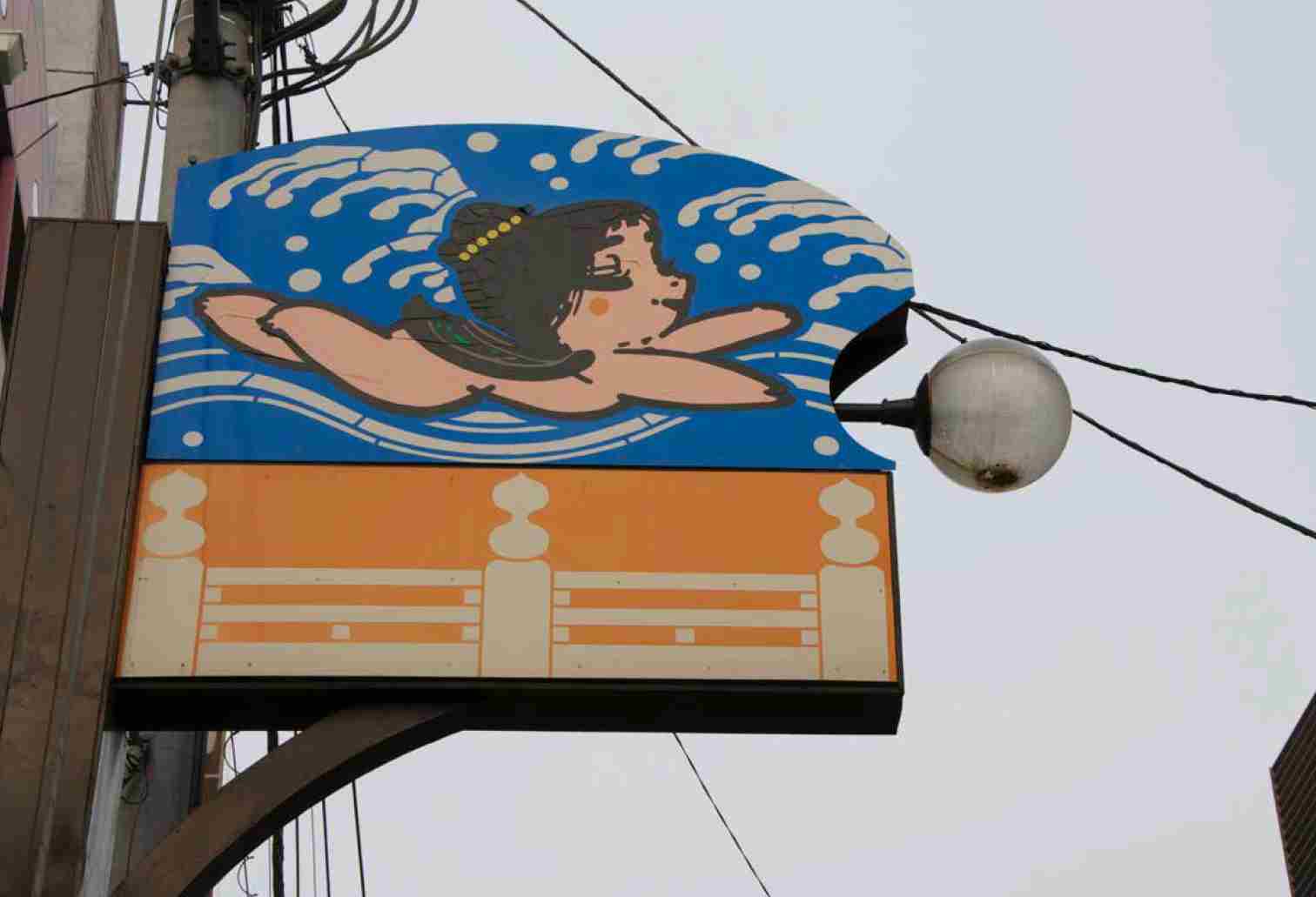
▲ Near Asakusa Imahan in the Kappabashi neighborhood, a sign includes female kappa.

▲ The grave stone of Hokusai at Seikyōji shows signs of fire damage.

▲ ▼ Art symbolizing various festivals can be found on the shutter of the Drum Museum.
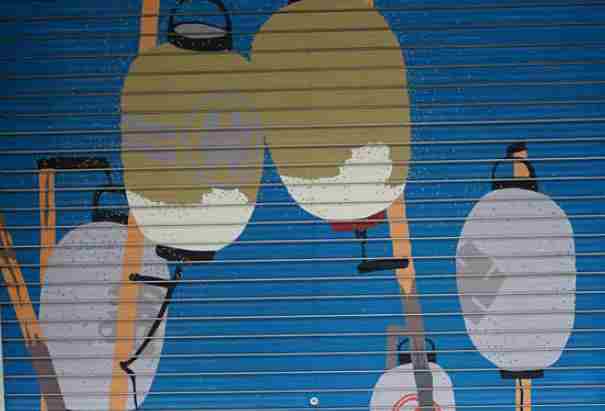
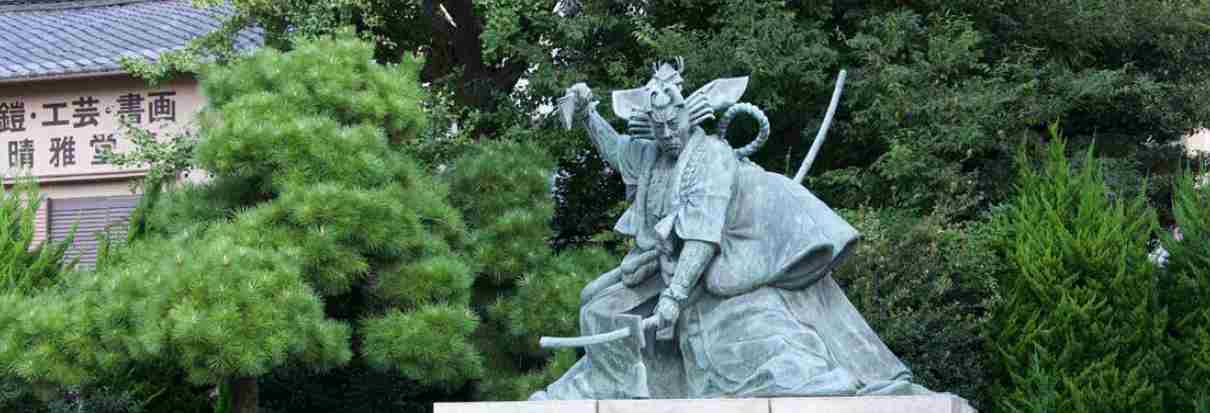
▲ The bronze statue of Ichikawa Danjūrō IX depicted as the hero of the kabuki play ‘Shibaraku.’
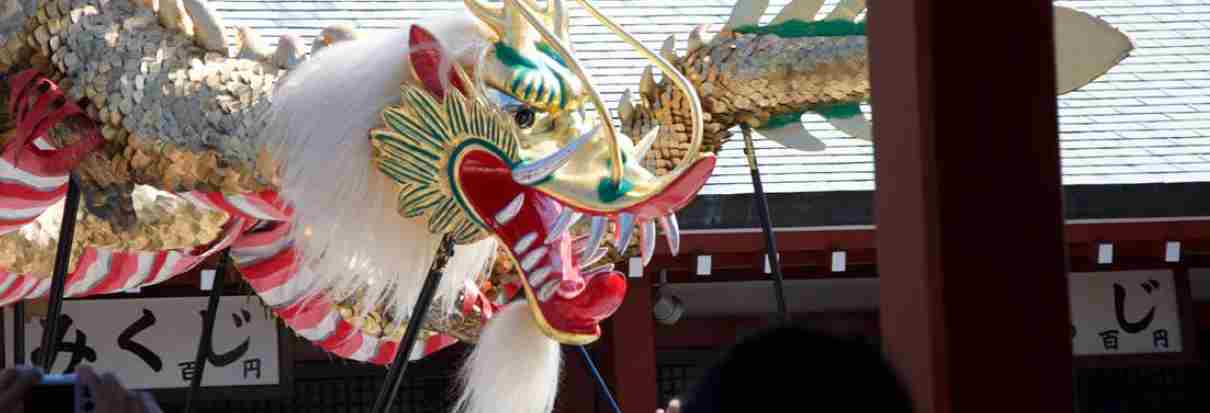
▲ The Golden Dragon dance is held at Sensōji on the 18th of March and October each year.
Japan’s oldest amusement park, founded in 1853 and located just west of Sensōji. The name means “flower mansion” and this compact park was originally a botanical garden, with later additions of caged animals and entertainers in booths. Over time the park started adding other attractions, such as a puppet theater, rides, and a movie theater. The park was destroyed in the Great Kantō Earthquake and rebuilt with different attractions. Today the park manages to pack a large variety into a small area with multistory structures. Attractions include rides, small restaurants, shops, a haunted house, a 3D theater, a multistory labyrinth, traditional festival games, an arcade, fortune tellers, rooftop gardens, and even occasional masked wrestling.
 http://www.hanayashiki.net/en
http://www.hanayashiki.net/en
 Ichikawa Danjūrō IX “Shibaraku” bronze statue 九代目市川團十郎「暫」銅像
Ichikawa Danjūrō IX “Shibaraku” bronze statue 九代目市川團十郎「暫」銅像
This statue is one of several points of interest related to kabuki that are scattered about Asakusa. It depicts the young Kamakura Gongorō, the main character from the famous kabuki play Shibaraku, in a classic mie pose. The specific actor depicted in this role is Ichikawa Danjūrō IX (1838–1903). A local legend has it that Sensōji survived the fire after the Great Kantō Earthquake because this statue held back the flames. The original statue was impounded by the Japanese military in 1944 and melted down for armaments, and the temple was destroyed in the firebombings of 1945. Ichikawa Danjūrō XII had the present reproduction placed here in 1986. Each year on the fourth Sunday in April there is a nakizumō crying baby contest in commemoration of the rebuilding of the statue.
 Edo Taitō Traditional Crafts Museum / Edo Taitō Dentō Kōgei Kan 江戸下町伝統工芸館
Edo Taitō Traditional Crafts Museum / Edo Taitō Dentō Kōgei Kan 江戸下町伝統工芸館
When you hear the name of this museum you may think, as I did, that it is filled with exhibits of musty artifacts from the past. Nope, everything is new: the museum was founded in 1997 to highlight the traditional crafts that are still practiced in the area. On the second floor you will see many excellent examples of such crafts including furniture, dolls, traditional lanterns, hairpins, metalwork, cut glass, woodblock prints, and embroidery, as well as tools. There is an exhibit space on the ground floor where, if you go on a weekend, one of the local artisans may be giving a demonstration. Today a large percentage of Tokyo’s practitioners of traditional crafts live and work in Taitō Ward. The reception desk has a pamphlet of locations of the various studios and shops in the area. You can also buy many small items in the museum shop.
 https://craft.city.taito.lg.jp/en/kogeikan/
https://craft.city.taito.lg.jp/en/kogeikan/
A specialty shop for festival goods such as happi coats, tenugui, pants, tabi socks, and waraji sandals woven from straw cords. They make the products they sell, even doing the cloth dyeing. Sizes range from children’s to 3L (US XL or 85-93 cm). The shop is located on Hisago Dōri, between the Traditional Crafts Museum and Kototoi Dōri.
DETAIL 5
A company that provides charter services with a traditional type of roofed party boat dating from the Edo period known as yakatabune. Their typical tour lasts about one and a half to two hours and goes down the Sumidagawa, under the Rainbow Bridge, and back. They also have special tours for the annual summer fireworks show and cherry blossom viewing season. The smaller boats seat sixteen on tatami mats, the largest seventy with table seating. Food and drink are part of the packages. Their offices are located one block inland from their docks on the river.
This shop established in 1852 sells a variety of traditional sweets handmade in house. The ice cream is freshly made, as well as the sweet bean paste used in many items they sell. The menu varies a little by season. Some items are available to take out.
 https://www.asakusa-nishiyama.com/english-top/
https://www.asakusa-nishiyama.com/english-top/
Oldest Western-style bar in Tokyo, opened in 1880, founded by Kamiya Denbe. This was the first bar in Japan to use the English word “bar” in its name. Kamiya Bar has three floors: the first is a bar, the second and third are restaurants. Each floor has a different menu with some overlap. While it is in every English language guidebook I have looked at, you almost never see tourists in the place. Perhaps this is because it is very much an unpretentious neighborhood bar. They serve their signature brandy cocktail Denki Bran, “Electric Brandy,” which can also be purchased in bottles, at night, at a counter on the sidewalk. Denki Bran is a popular and inexpensive souvenir among Japanese who want to take something local home as gifts. You can also buy Chateau Kamiya wine from Japan’s first full-scale winery, which began operation in 1903. The current Kamiya Bar building dates from 1921. In 2011 the building was designated as a National Tangible Cultural Property by the Japanese government.
ASAKUSA DETAIL 5
Several companies depart from this station. Routes either go downstream toward other landings or to Tokyo Bay.
Tokyo Cruise Ship Company operates three futuristic-looking enclosed water buses named Himiko, Hotaluna and Esmeraldas. These were designed by the Japanese science fiction manga writer Matsumoto Leiji. Himiko is the only one that is fully enclosed; Hotaluna and Esmeraldas have rooftop decks for when the weather is nice.
Tokyo Mizube Line is operated by the Tokyo Metropolitan Government Park Association.
Tokyo Water Taxi is available for small groups and as a taxi service.
Tokyo has many docks that are maintained by the government for emergency use, and the government has been opening more of these to water bus and water taxi service as part of encouraging such transportation. I have also noticed new docks along the river, so the system is expanding.
Tokyo Cruise Ship Company:
Tokyo Mizube Line:
 https://www.tokyo-park.or.jp/waterbus/index.html
https://www.tokyo-park.or.jp/waterbus/index.html
Tokyo Water Taxi:
 https://www.water-taxi.tokyo
https://www.water-taxi.tokyo
Go Tokyo page on Tokyo Water Taxi:
 https://www.gotokyo.org/shuun/en/course/020.html
https://www.gotokyo.org/shuun/en/course/020.html
 Sumida Park / Sumida Kōen 隅田公園
Sumida Park / Sumida Kōen 隅田公園
This park is on both sides of the Sumidagawa. This entry covers the park on the west bank; for information on the east bank side, see the chapter for Northwestern Sumida Ward. This park was part of mayor Gotō Shinpei’s reconstruction plan after the Great Kantō Earthquake. The goal was to create a space both for relaxation and for evacuation in case of future disasters. The park starts at Azumabashi and continues upstream past Sakurabashi. Each spring people congregate here for flower viewing, as the park has variety of cherry trees, camellias, and ume (plum) trees. On the last Saturday in July, the fireworks show packs the park with onlookers.
 Asakusa Underground Shopping Street / Asakusa Chika Shōtengai 浅草地下商店街
Asakusa Underground Shopping Street / Asakusa Chika Shōtengai 浅草地下商店街
A shōtengai is a local shopping street. These are found throughout Japan, often close to a train station. This particular one was founded in 1955 and is located between the Ginza subway line’s Asakusa Station and the EKIMISE Department Store. This is literally the Tokyo underground: a subterranean walkway lined with small inexpensive shops, restaurants, fortune tellers, barbers, and so on. When open, many of the businesses overflow onto the narrow walkway to provide a little extra space for their customers and signage. Nothing fancy, but with an old-fashioned ambiance that provides a relaxing environment for those wanting a glimpse of Shōwa period Tokyo.
A shopping mall housed in an art deco building. The name literally means Station Shops. The building opened in 1931 next to the Asakusa station for the Ginza Line and the second floor houses the terminus for the Tōbu Railways Skytree Line. For many years this was a Matsuya department store and they still occupy several floors. The basement has a variety of food shops for takeout, and the seventh floor is mainly restaurants. The building has a rooftop terrace with a great view across the Sumidagawa toward the Asahi brewery and Tokyo Sky Tree. In the summer the rooftop becomes a beer garden. The basement has a connecting passageway that takes you to the Asakusa Underground Shopping Street.
DETAIL 6
A mid-priced restaurant specializing in Edo-style tempura, meaning only seafood, no vegetables. It was founded in 1870; before the restaurant was opened, the founder sold tempura at a local stall. The architecture is old-fashioned, in the style of a traditional storage building, with a large stone lantern out front. There are twelve private dining rooms around a courtyard garden with a koi pond. To go orders are possible.
There is an English menu. Seating is Western and on tatami. Entrance is off Orange Street.
This temple is said to have been founded in 1872 to discourage tanuki (raccoon dogs) from damaging a garden at Sensōji by encouraging people to come to that part of the grounds. This association with tanuki quickly resulted in the temple being referred to as “Otanuki Sama.” The shrine was moved to the present location in 1883, and the the shrine was rebuilt in 1913. Tanuki Dōri, a street south of the shrine, is worth a visit for its distinctive streetlamps. This shrine is known for prayers for business success, as well as protection against fire and theft. Festival rites are conducted on March 17 and 18 every year.
ASAKUSA DETAIL 6
A shop founded in 2014 by David Bull, a carver of traditional woodblocks forprintmaking. Bull has been practicing his craft in Tokyo for decades and strives for perfection. The shop has a staff who produce beautiful and affordable hand-printed works. There is also a broad selection of prints from other printmakers available for purchase. Viewing such prints directly shows details that photos do not reveal, such as the same color printed with shiny and dull finishes, or patterns pressed into the paper creating subtle shadows that add to the impact of the image. At the shop you can sign up to join a Print Party, where you make a simple multicolor print from woodblocks using traditional implements and techniques. Aprons are provided, the inks are non-toxic, and school-age kids can participate. Imagine taking home a souvenir you have printed yourself.
 https://mokuhankan.com/index.php
https://mokuhankan.com/index.php
In the Meiji period, the rokku (sixth) section of Asakusa Park was the area with the theaters, opera houses, music halls, and, starting in 1903, cinemas. Destroyed during the Great Kantō Earthquake, the area was rebuilt with cabarets and musical reviews such as the famous Casino Follies. In 1929 a young Kawabata Yasunari began writing a series of popular articles about Asakusa in the Asahi newspaper and the number of visitors to this area climbed. After suffering from the heavy censorship of the wartime government and the firebombings of World War II, Rokku again rebuilt and new forms of entertainments such as strip clubs and porn theaters arose and then declined. Today this area is mostly retail shops and bars, but theater still exists here with the continued presence of Asakusa Mokubakan with traveling acting troupes, Asakusa Engei Hall for rakugo, and the Asakusa Kōkaidō with kabuki, among other entertainments.
One of a few theaters in Tokyo where there are daily performances of rakugo story telling. The building has been the venue for a variety of entertainments since it first opened in 1907. These days it is mainly used for rakugo, even if other types of performances are occasionally presented. I have observed audience members waiting outside that ranged from the very elderly to middle school students, either on a field trip to the area or skipping school to see a performance. Skipping school to see rakugo? If I was their teacher, I would give them extra credit.
 http://www.asakusaengei.com
http://www.asakusaengei.com
An old-fashioned Japanese neighborhood diner since 1950. There are two floors, Western seating on the first, Japanese with cushions on tatami on the second. The food is straightforward, simple, tasty, and, with some 100 dishes, quite varied. You can order a la carte or set meals. Their drink menu includes beer, sake, shōchū, wine, whisky, alcopops (soft drinks with a low alcohol content), and soft drinks. Credit cards accepted. English menu available
 http://asakusa-mizuguch.main.jp
http://asakusa-mizuguch.main.jp
DETAIL 7
A sushi restaurant established in 1910, located near the midpoint of Sushiya Dōri. Only seafood in season is used. The menu has a large selection of chirashizushi (scattered sushi), nigirizushi (topping on rice), and zukedon (marinated tuna on rice). They have a broad selection of sake and other alcoholic beverages. There is Western-style counter and table seating. The second floor is has a banquet hall and private rooms with Japanese seating on tatami.
ASAKUSA DETAIL 7
 HUB Asakusa shop / HUB Asakusa Ten / HUB 浅草店
HUB Asakusa shop / HUB Asakusa Ten / HUB 浅草店
Normally I would not recommend a branch of a chain of British-style pubs. However the HUB in Asakusa is an exception. It is a jazz club with music every night, open 365 days a year. There is a cover charge earlier in the evening. The place is popular with locals, the beer varied, seating is non-smoking though there is a smoking booth, and the bands constantly change.
 https://www.pub-hub.com/index.php/shop/detail/6
https://www.pub-hub.com/index.php/shop/detail/6
In a mixed commercial and residential area, this is a humble shrine to Inari that is located behind a small gate. Such shrines, many even smaller, are scattered throughout the city, a testimony to the devotion this deity has enjoyed in Japan. If the gate is open, consider visiting the shrine, respectfully take a picture or two, leave an offering, and, perhaps, a prayer.
A restaurant operating since 1926, specializing in kama meshi: rice dishes cooked and served in a small wooden-lidded kama, a type of iron pot. Kamameshi Haru is considered the first restaurant to specialize in this cuisine. While rice is the main ingredient, what goes with it can vary greatly, even including uncooked toppings. Seasonal dishes are also offered. Seating is both traditional and Western style. Take-out orders are possible. English, Chinese, and Korean menus are available.
Located a little way south of Chingodō, this one block long street is easy to identify, as the base of each lightpost has a red enclosure with a different small statue of a tanuki dressed in human clothes. The statues are quite whimsical—you can find Buddhist priests, Shōki the Demon Queller, and more. It is not unusual to see someone photographing each and every statue.
 Yagenbori Nakajima Shōten やげん堀 中島商店
Yagenbori Nakajima Shōten やげん堀 中島商店
See entry 15 for detail map 1.
DETAIL 8
On Asakusa Dōri from Inarichō to Kokusai Dōri are shops specializing in Shintō and Buddhist home altars, as well as related implements and small outdoor shrines. The shops are mainly on the south side of the street, to prevent direct sunlight from damaging the wooden goods. Some of these shops are just suppliers of Shintō items or specific Buddhist sects; others are more general, serving more than one sect or religion. There also a few shops near the intersection with Kokusai Dōri. The name Butsudan Dōri, appropriately titled “the street of household Buddhist altars,” is an informal one often used to refer to this group of shops.
 Kappabashi Street / Kappabashi Dōgugai かっぱ橋道具街
Kappabashi Street / Kappabashi Dōgugai かっぱ橋道具街
An entire street devoted to supplies for restaurants and caterers. While a few of the larger shops stock a variety of supplies, almost all of the shops specialize in one type of product. There are shops for chairs and stools, for food replicas, for restaurant stationery, for cloth items, for knives, for signage, for traditional paper lanterns, even a shop for rustic items to give your business a time-worn and rural look, and so on. At least one of the plastic sample food shops has a hands-on workshops. Kappabashi is lined with carved wooden sign holders in the shape of a cute swimming female kappa. If you are in Asakusa Dōri, look for the landmark on top of the Niimi Building at the intersection: a statue of the head of a chef that is 39 feet (11.7 meters) tall.
 Honzan Higashi Honganji 本山東本願寺
Honzan Higashi Honganji 本山東本願寺
A Jōdo Shinshū Buddhist temple. Originally in Kanda, it was relocated to
Asakusa after the Meireki fire. During World War I the temple grounds were used to house captured sailors from the German Navy. After the Great Kantō Earthquake the temple again burned down and was replaced with a reinforced concrete structure. The interior of the building was gutted during the March 1945 firebombing of Tokyo in World War II. In the 36 Views of Mount Fuji by Hokusai, the print titled Tōto Asakusa Honganji captures the rooftop of this temple with a kite and Mount Fuji visible in the distance.
 http://honganji.or.jp/index.shtml
http://honganji.or.jp/index.shtml
ASAKUSA DETAIL 8
OFF THE CHARTS
Ikenami Shōtarō Memorial Museum / Ikenami Shōtarō Kinen Bunko 池波正太郎記念文庫
If you follow the main street of the Kappabashi shopping area north, you will reach a very large building that is home to the Taitō Kuritsu Central Library and Taitō City Lifelong Learning Center. On the first floor is a museum devoted to the writings of Ikenami Shōtarō (1923–1990). The museum was planned as a part of this new library and opened in 2001. Displays include photographs he took for reference, a large collection of books, his manuscripts and paintings, maps he drew to aid in plotting scenes in stories, and a reconstruction of his study filled with items he owned. Ikenami Shōtarō was born and raised in the Asakusa area and early on worked scripting plays for the Shinkokugeki theatrical company. To date, the only works translated in English are two: Master Assassin and Bridge of Darkness, from his Shikakenin Fujieda Baian series. The Baian series was adapted into more than one TV series; the one starring Watanabe Ken was released in the United States on subtitled DVD in 2006.
 https://www.culture.city.taito.lg.jp/bunkatanbou/culture/ikenami/ikenami_e.html
https://www.culture.city.taito.lg.jp/bunkatanbou/culture/ikenami/ikenami_e.html
This shop was founded in 1988 by the Miyamoto Unosuke Shōten company, makers of traditional musical instruments and mikoshi. The ground floor is a shop; the museum is upstairs, accessible by elevator. The museum houses a collection of hundreds of drums and percussion instruments from around the world. There are even some props used for sound effects in kabuki. Several drums in the museum are marked to let you know you can play them.
A shop specializing in knives located on Kappabashi Dōri. They sell over 800 different Japanese and Western knives, Japanese whetstones, and a selection of kitchen gadgets. Operating since 1923, they originally just repaired or sharpened knives and later they expanded into sales. They still do knife repair and sharpening, and now offer knife sharpening classes. Free hand engraving on knives purchased there is available.
English-speaking staff are on site.
DETAIL 9
A shrine dedicated to the mythical kappa on the grounds of Sōgenji. The roof’s end tiles have kappa faces on them and there are several kappa statues near the shrine. According to one legend, a local merchant wanted to improve drainage in this marshy area. At one time he had saved a kappa from a trap, so various kappa helped with the project. You may be able to arrange to go inside the shrine if you have Japanese-speaking friends call and make an appointment. Allow a week or two for this, as the temple staff may be busy. Do this properly and have a modest gift of some paper money in an envelope to give thanks—be a little generous. When you are inside, or just peeking through the glass, you will see several objects. These include an altar with offerings, panels on the ceiling painted by famous manga artists, and a glass case with small items including a mummified kappa arm. As this is a religious shrine, do be respectful.
The entrance to the grounds is on the south side.
 Fukuzendō Sakai Kanbanten 福善堂坂井看板店
Fukuzendō Sakai Kanbanten 福善堂坂井看板店
This business has been run by the Sakai family since 1924, producing traditional carved signs such as kanban (business signs), signs for Shintō shrines and Buddhist temples, sponsors’ placards at kabuki plays, and mon (crests) for businesses, schools and families. They did the restoration work on the large sign for the Mistukoshi Department Store in Nihonbashi. Their clients are found in all parts of Japan, so they may be working off site and closed at times.
 http://www.interq.or.jp/tokyo/fukuzen/
http://www.interq.or.jp/tokyo/fukuzen/
This shop has been in operation since 1908 and specializes in finely crafted traditional and modern cooking supplies such as knives, charcoal grills, and pots and pans. Many items are made from wood, bamboo, or natural fibers. Knife repair and sharpening are also handled by the store. The knife selection is impressive, including not only highly specialized blades but regional variants of knives used for the same task. For example, they have four different knives designed for fileting eels. Free engraving of knives purchased is available on request. English- and French-speaking staff are on hand.
 http://www.kama-asa.co.jp/en/
http://www.kama-asa.co.jp/en/
A restaurant serving dishes based around the humble dojō (loach) since
1903. Seating is traditional or Western style in chairs. Be aware that in some of the nabe dishes the fish are cooked whole, bones, guts and all; be sure to chew it well. You can also order boneless and gutless dishes, such as kabayaki, in which the fish are cut open lengthwise and grilled.
ASAKUSA DETAIL 9 WEST
This sukiyaki restaurant originally opened in the Honjō Azumabashi neighborhood in 1895 as Imahan; in 1913 the Asakusa location opened near the Kaminarimon. The restaurant changed its name in 1928 to Asakusa Imahan and moved to the present location on Kokusai Dōri. The current three-story building dates from 2008, with both Western and traditional seating. They use wagyu beef in their products and since 1945 have made tsukudani from beef in their own sauce. They also sell beef tsukudani, and various cuts of meat in boxes, which are available at many department stores.
 http://www.asakusaimahan.co.jp/english.
http://www.asakusaimahan.co.jp/english.
DETAIL 10
 Bandai head office building バンダイ本社ビル
Bandai head office building バンダイ本社ビル
The offices of the internationally famous toy and hobby division of Bandai Namco are easy to spot, with its sculptures of characters from famous animated and live action shows. Just look for a street with full-sized statues of Doraemon and Kamen Rider, and a smaller Ultraman. The lobby of the building is filled with display cases of toys and other products sold by the company. If they happen to be closed when you wander by, you can still see a large portion of the exhibits through the windows on the street.
ASAKUSA DETAIL 9 EAST
A shop that makes and sells all sorts of traditional lanterns with a large variety of shapes, sizes, and designs. They have been in business since 1854. They produce lanterns for shrines, temples, restaurants, and ryokans, as well as for ceremonies, gifts, homes, shops, and any other use. They stock lanterns to be hung, mounted, handheld, and for special purposes. Some of the Edo period designs include those for use on horseback, on boats, and while walking at night. The majority of lanterns are handmade from traditional materials such as bamboo and washi paper. In some types, modern materials may be preferred, such as metal, Western paper, or vinyl. Also stocked are accessories including gift boxes, electric lights in the shape of candle flames, hanging lights, clear vinyl covers, special long poles for raising the lantern high, and floor frames for free-standing display. Custom-made lanterns are a regular part of the business.
ASAKUSA DETAIL 10
A restaurant with a menu centered around dojō (loach), a small freshwater fish found in many parts of Japan. As the fish are small and sometimes cooked whole, some dishes may include soft bones, so you may need to chew those well. The building, modeled on the original wooden structure from 1801, has two floors above ground and a basement level. There is both traditional Japanese floor seating and Western chair seating depending on the floor. Komakata Dozeu is very proud of its history and every other month they host a presentation, in Japanese, on Edo period culture; in 2011 they were granted a MECENAT Award for this work. One traditional element you will see is small dishes at the entrance filled with purifying salt.
 World Bags and Luggage Museum / Sekai no Kaban Hakubutsukan 世界のカバン博物館
World Bags and Luggage Museum / Sekai no Kaban Hakubutsukan 世界のカバン博物館
A unique museum operated by luggage maker Ace. The humble bag—may it be a purse, pouch, backpack, attaché case, suitcase, or other means of carrying items—has various forms and uses throughout the world. The collection is well displayed in cases with good lighting. For decades Ace founder Shinkawa Ryūsaku collected hundreds of such items from around the world for this collection, which he made available for public viewing in 1975. The range of materials used to make them is as interesting as the bags themselves.
 https://www.acejpn.com/about/csr/museum.html
https://www.acejpn.com/about/csr/museum.html
Originally Maekawa was a wholesaler of river fish. The founder then turned it into an eel restaurant in the early 19th century. Located on the Sumidagawa, its name can be translated as “river front.” The second and third floors have tatami rooms with Japanese-style seating. The season for wild Japanese eel is generally May through November; at other times, they use high-quality farmed domestic eel from the Tone River area. Farming eel in Japan has been going on since 1879 and they have found good sources.
 http://www.unagi-maekawa.com
http://www.unagi-maekawa.com
 http://www.norenkai.net/en/portfolio-item/maekawa/
http://www.norenkai.net/en/portfolio-item/maekawa/
A workshop and gallery focusing on traditional woodcarvings for shrines, temples, and households since the Meiji period. They also make and sell the small ornamental sculptures called netsuke, as well as do restoration and repair. The first floor is a gallery of their work.
A small temple to Batō Kannon “Horse-headed Kannon” next to the Sumidagawa, originally built in 942. Tradition has it that this was the location where the fishermen brothers Hinokuma Hamanari and Hinokuma Takenari found the famous Kannon statue that is at Sensōji. This place was also where boats carrying people to the temple would dock, so pilgrims would first pray here before traveling on. Now prayers for traffic safety are offered here. The nearby bridge, called Komagatabashi, and the Komagata neighborhood are named after this temple. The temple is also seen in several ukiyo-e prints including some by such famous artists as Hokusai and Hiroshige. The present building dates from 2003, replacing the 1933 structure that replaced the one destroyed in the Great Kantō Earthquake.
There is a festival each April 19.
ASAKUSA DETAIL 11
DETAIL 11
Seikyōji 誓教寺
Located in Moto-Asakusa, four blocks west of Kappabashi Dōri and south of Asakusa Dōri on Saemonbashi Dōri, is a small Buddhist Temple of the Jōdo Shinshū sect. At the entrance there is a sign—the same kind you see around the neighborhood for various landmarks—with the temple name and a note that Katsushika Hokusai’s grave is located here. The connection with Hokusai is what will interest most tourists. Enter the grounds from the west and look a little to the left: You will see a bust of Hokusai that is placed facing in the direction of Mount Fuji. If you turn right and go along the side of the temple priest’s residence, you will reach the graveyard. Hokusai’s grave is easy to identify as it has a wooden roof over it. There is a small box with a slot in it and some postcards in Japanese. If you want a postcard, leave a small offering in the box.
NOTE: When I visited, the priest pointed out that the inscription on the gravestone says “ Crazy Old Man.”
